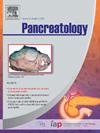Impact of islet autotransplantation on 30-day post-operative outcomes in patients undergoing total pancreatectomy: A NSQIP retrospective cohort analysis of 584 patients
IF 2.8
2区 医学
Q2 GASTROENTEROLOGY & HEPATOLOGY
引用次数: 0
Abstract
Background
Total pancreatectomy (TP) offers a surgical option for refractory pancreatitis, yet confers substantial long-term morbidity associated with resultant diabetes. While total pancreatectomy with islet autotransplantation (TPIAT) offers an intuitive solution, data evaluating its safety have been limited to single-center studies. The aim of this study is to evaluate whether the addition of islet autotransplantation to TP confers additional post-operative morbidity within the 30-day post-operative period.
Methods
This is a retrospective cohort study of prospectively collected cases from the National Surgical Quality Improvement Program (NSQIP) database. Cases of TP with or without islet autotransplantation from 2016 to 2021 were included. Baseline demographics, and a comprehensive list of 30-day postoperative outcomes were evaluated. Multivariable logistic regression models were constructed to evaluate the impact of each factor on 30-day complications.
Results
A total of 584 cases were included with 171 (29.2 %) patients undergoing TPIAT. TPIAT patients were younger (58.8 vs. 39.5; p < 0.0001), and had lower incidences of pre-existing diabetes (41.4 % vs. 19.9 %; p < 0.0001) and hypertension (48.2 % vs. 24.6 %; p < 0.0001). TPIAT cohort had longer length of stay (10.3 days vs.12.2 days; p = 0.0006). There was no difference in overall rates of serious complications between the two cohorts (50.1 % vs. 45.0 %; p = 0.263). After adjusting for demographic differences between cohorts using multivariable logistic regression models, TPIAT was not associated with serious complications (OR 0.71; p = 0.168) compared to TP alone.
Conclusion
The results from this study suggest that TPIAT does not appear to be associated with increased 30-day morbidity, and should be considered in patients to mitigate the long-term morbidity associated with diabetes mellitus post TP.
胰岛自体移植对全胰腺切除术患者术后30天预后的影响:584例患者的NSQIP回顾性队列分析
背景:全胰腺切除术(TP)为难治性胰腺炎提供了一种手术选择,但也会导致与糖尿病相关的长期发病率。虽然全胰切除术联合胰岛自体移植(TPIAT)提供了一种直观的解决方案,但评估其安全性的数据仅限于单中心研究。本研究的目的是评估胰岛自体移植在TP术后30天内是否会增加术后发病率。方法:这是一项回顾性队列研究,前瞻性地从国家外科质量改进计划(NSQIP)数据库中收集病例。包括2016年至2021年合并或不合并胰岛自体移植的TP病例。对基线人口统计数据和术后30天的综合结果进行评估。构建多变量logistic回归模型评估各因素对30天并发症的影响。结果:共纳入584例患者,其中171例(29.2%)接受TPIAT治疗。TPIAT患者更年轻(58.8 vs 39.5;结论:本研究的结果表明TPIAT似乎与30天发病率增加无关,应考虑在患者中减轻TP后糖尿病相关的长期发病率。
本文章由计算机程序翻译,如有差异,请以英文原文为准。
求助全文
约1分钟内获得全文
求助全文
来源期刊

Pancreatology
医学-胃肠肝病学
CiteScore
7.20
自引率
5.60%
发文量
194
审稿时长
44 days
期刊介绍:
Pancreatology is the official journal of the International Association of Pancreatology (IAP), the European Pancreatic Club (EPC) and several national societies and study groups around the world. Dedicated to the understanding and treatment of exocrine as well as endocrine pancreatic disease, this multidisciplinary periodical publishes original basic, translational and clinical pancreatic research from a range of fields including gastroenterology, oncology, surgery, pharmacology, cellular and molecular biology as well as endocrinology, immunology and epidemiology. Readers can expect to gain new insights into pancreatic physiology and into the pathogenesis, diagnosis, therapeutic approaches and prognosis of pancreatic diseases. The journal features original articles, case reports, consensus guidelines and topical, cutting edge reviews, thus representing a source of valuable, novel information for clinical and basic researchers alike.
 求助内容:
求助内容: 应助结果提醒方式:
应助结果提醒方式:


